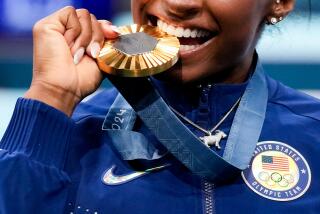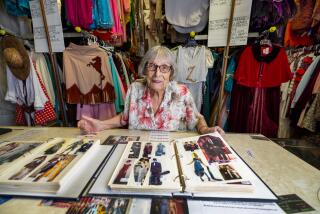Today’s Collectibles Were Once a Throne’s Stone Away : A Good Imitation Can Be a Real Gem to Friends of Faux and Other Costume Jewelry
- Share via
A Madame Gripoix necklace made in the 1960s and sold for less than $100 went for $1,955 recently at a New York auction. Does it contain pearls and diamonds? No. It has imitation gems: five strands of emerald glass beads with small rhinestone beads and a medallion of rhinestones and emerald glass.
Why so much for costume jewelry?
One reason is that it came from designer Gripoix, who worked with couture houses to accessorize their pricey clothes.
Another reason is that the costume jewelry made between the 1920s and the 1960s was created in much the same way as fine jewelry. Large, sparkling rhinestones and glittering faux gems and pearls allowed designers--who also often worked in precious stones for more expensive pieces--more room to be creative.
Collectors are searching for pieces that are valued because of their design and history.
*
Costume jewelry has a long, glittering history.
Methods of producing simulated precious gems are mentioned in the writings of Pliny the Elder in the First Century. A French government edict of 1331 made it illegal for members of the French goldsmith guild to create artificial precious gems because it was considered counterfeiting. Breaking the law resulted in flogging or banishment.
In 15th-Century Europe, only the royal family, nobles and clergy were allowed to wear gold, silver, precious gems or pearls because they symbolized power and high social standing. Others could not possess genuine or faux adornments.
It wasn’t until the 1650s, when the first factory to produce imitation stones in great numbers was built in Paris, that the old laws were set aside completely.
Often costume jewelry was a copy of an authentic precious piece. Look-alikes were made to deter theft.
In the late 1920s, however, designers stopped making fakes to look like jewelry from Tiffany, Cartier and Van Cleef & Arpels, and started creating original pieces from non-precious materials. The material shortages during the Depression and World War II initially gave them impetus. But later, costume jewelry designers broke away and made pieces that were bolder, livelier and brighter than their more expensive cousins. (Coco Chanel is credited with coining the term “costume jewelry” since she and other apparel designers preferred creating faux bijoux to complement the look of specific outfits.)
Besides the designs made for top fashion houses such as Chanel, Hattie Carnegie and Schiaparelli, upscale costume pieces were made by Miriam Haskell, Eisenberg and Trifari in the ’30 and ‘40s. Mass-market lines, such as Coro, Napier and Weiss, proliferated from the ‘50s to today.
*
With fabulous fakes selling for hundreds and thousands of dollars now, is it too late to start a collection? No. Most people don’t think of costume jewelry as a great craft, and there are plenty of antique shops, flea markets and auctions where pieces can be found at reasonable prices.
One such place is Antiques 4 U at 312 N. Newport Blvd., Newport Beach ((714) 548-4123). Prices range from $19 for whimsical pieces made from metals, plastics and ceramics to $200 for a highly collectible necklace by Miriam Haskell. There are Eisenberg rhinestone brooches and Trifari necklaces starting at $90.
“A piece is worth what you get for it,” said Nina Khodorovsky, owner of Antiques 4 U. “I have collectors who will buy any jewelry by Miriam Haskell over the phone without even seeing it.”
What do you look for in a piece of vintage costume jewelry?
The most important element is a good, strong design. It should be detailed, extravagant and glamorous.
Make sure the stones are prong-set, not glued, and that each stone is in place with no obvious repairs. Each pearl in a necklace should be individually knotted. Movable parts on a brooch or necklace are important and add to the value. Turn the piece over to check for joints and open-back settings, since they indicate craftsmanship.
Signed works often go for more, but not always.
There are many different styles and colors to chose from, because well-dressed women 50 years ago usually wore a full ensemble of jewelry in a particular style: a matching necklace, brooch, bracelet and earrings.
Dress clips were also popular in the ‘30s, when women wore collarless necklines. These matching brooches could be pinned on either side of the neckline, or, if the backs were convertible, worn as earrings or shoe buckles.
Brooches were really the signature pieces. They often represented figures of flowers, fruit, flags, crowns, birds, animals, fish and insects. Sometimes the pieces were full of rhinestones (often set in sterling silver); others had faux stones in every color of the rainbow made out of glass as well as plastic.
All were made well. Pieces were assembled by hand, with each fitting hinged with complex joints.
Local collectors may have bought the pieces themselves--Betty Moss, director of the Business Committee for the Arts, has a Haskell brooch and earring set--or have received them as a gift--Electa Anderson of Roger’s Gardens in Newport Beach received Eisenberg pieces from her mother and grandmother.
For the neophyte collector of vintage costume jewelry, it’s not too late to begin.
Rummage through shoe boxes in relatives’ houses and check antique stores and garage sales for a rare, well-designed piece. You may have a story to tell like the one of a dealer who sold a Madame Gripoix faux pearl and glass diamond necklace at 6 a.m. for $80. In the next hour, another dealer bought it for $450. By the end of the day, it was going for $1,500.
For more information, see “Costume Jewelry in Vogue” by Jane Mulvach (Thames and Hudson, $22.50); “Costume Jewelry: The Fun of Collecting” by Nancy N. Schiffer (Schiffer, $24.95); “Fifty Years of Collectible Fashion Jewelry” by Lillian Baker (Collector Books, $19.95); “Jewels of Fantasy: Costume Jewelry of the 20th Century” by Deanna F. Cera (Harry Abrams, Inc., $95).






